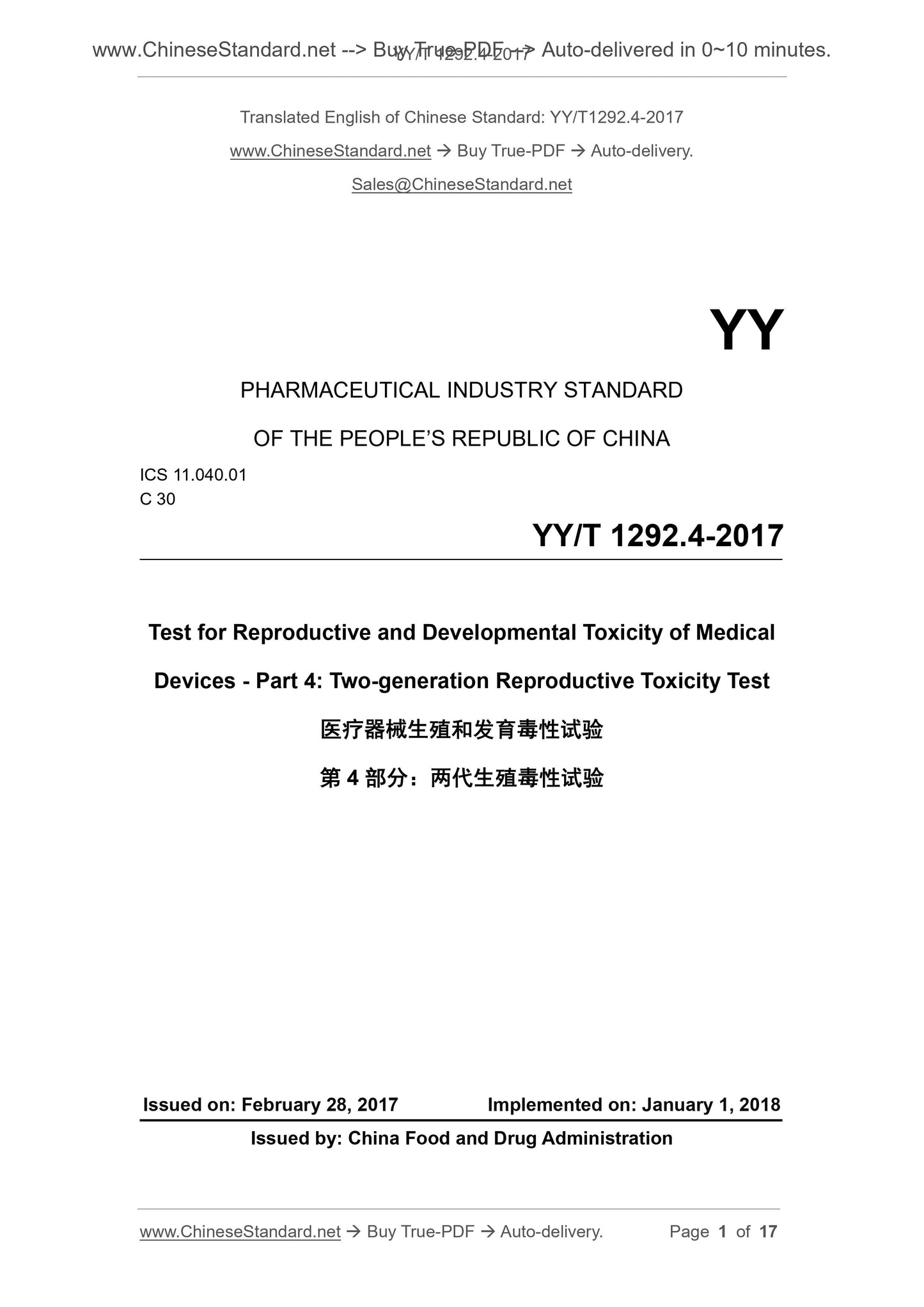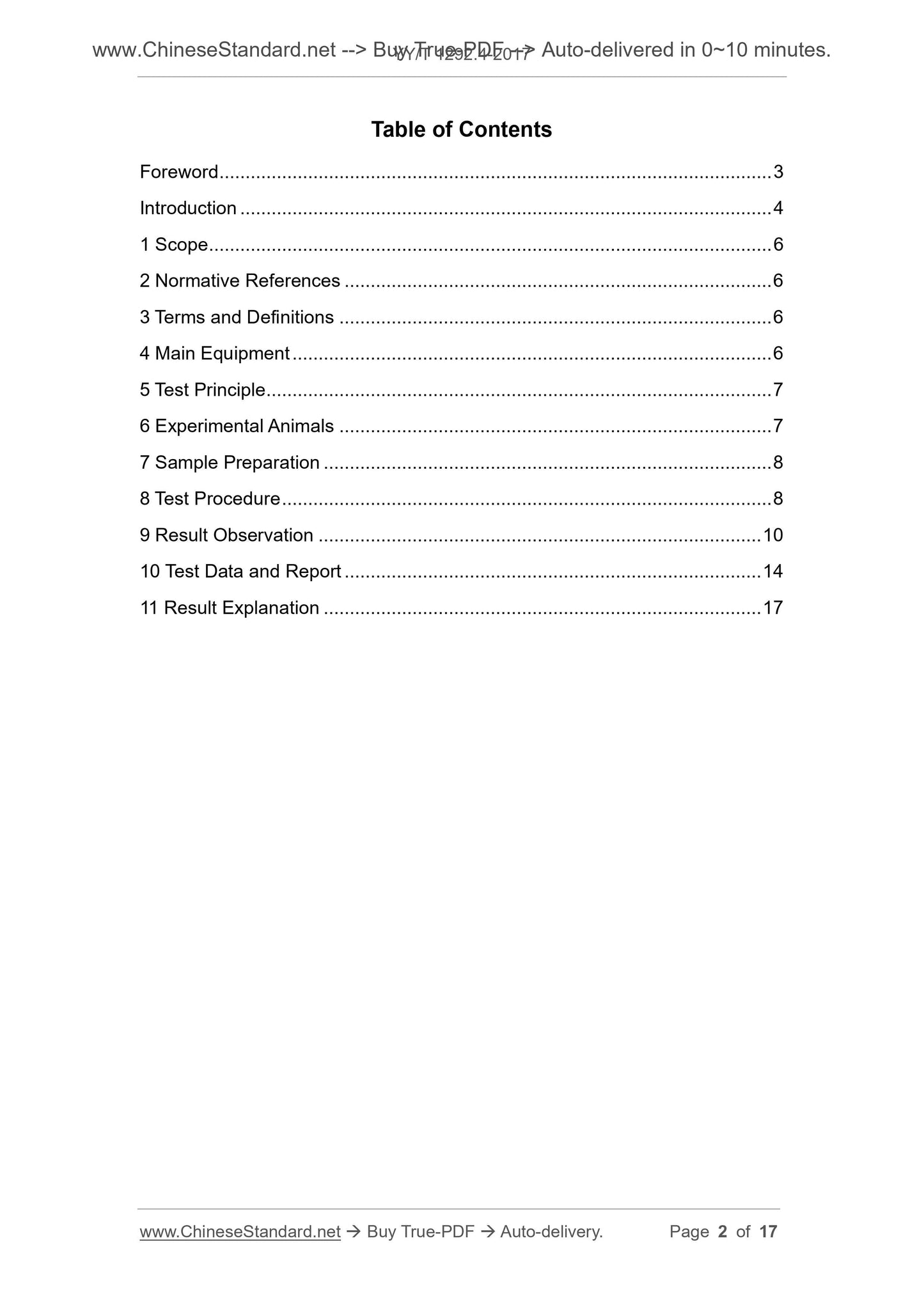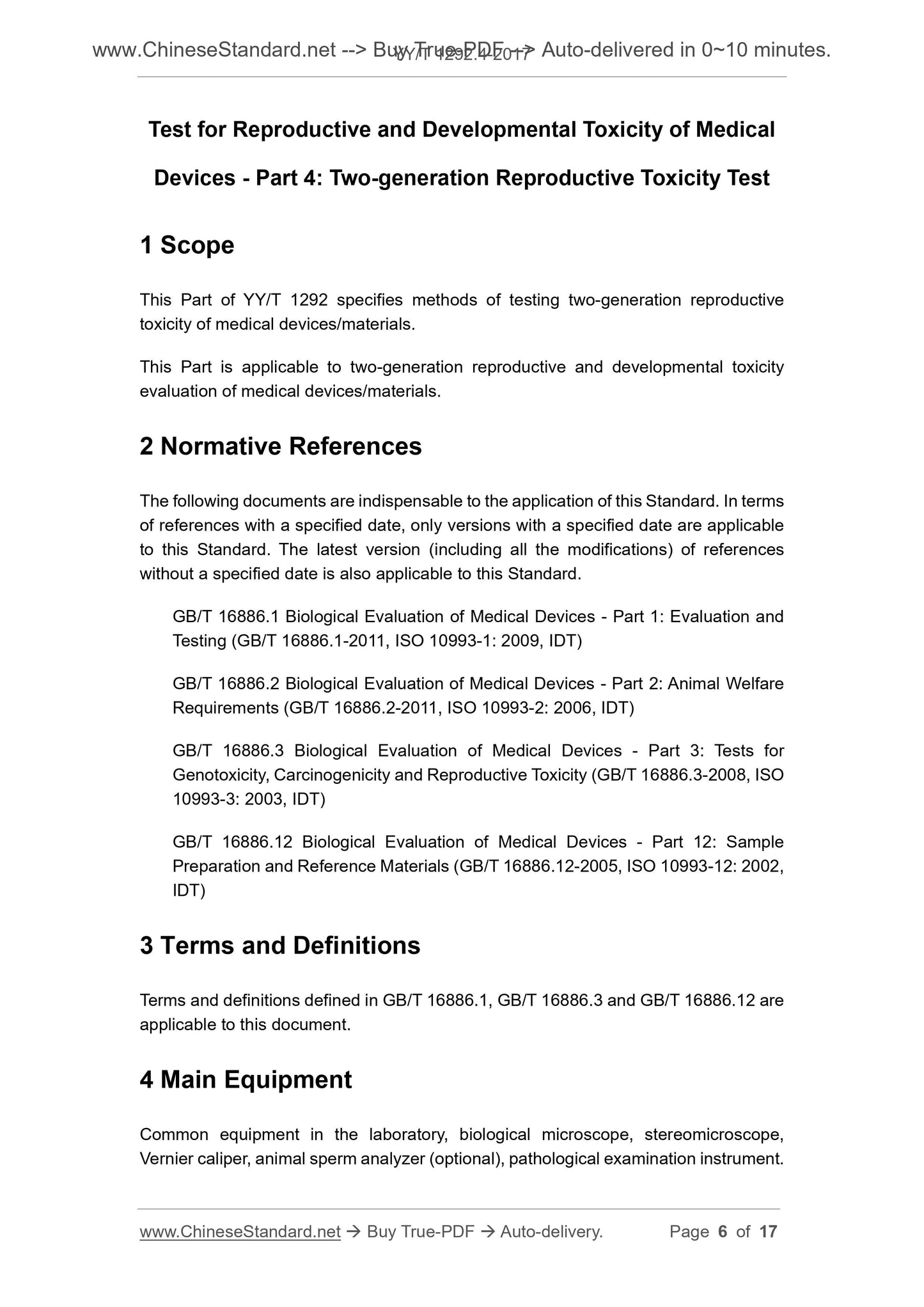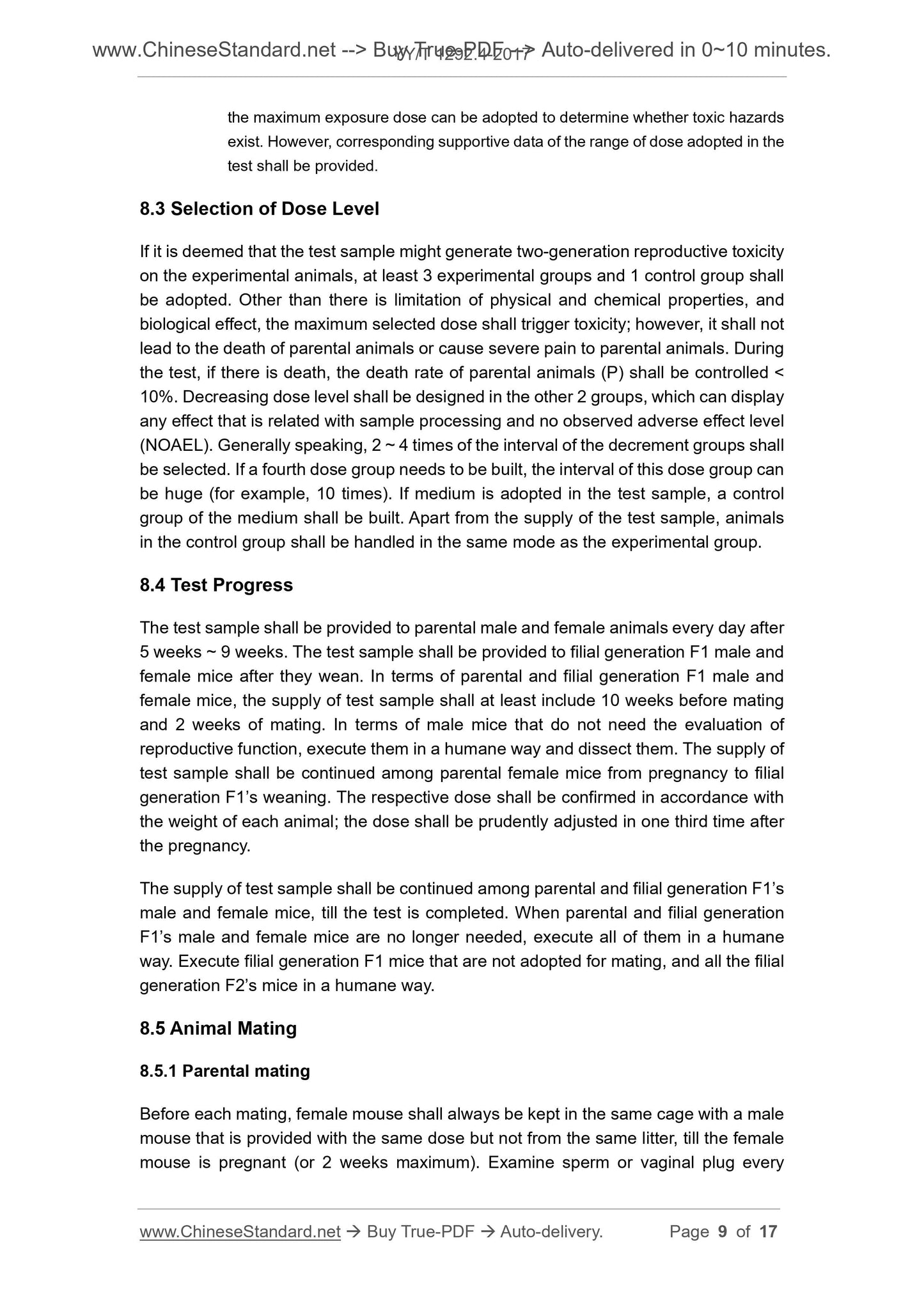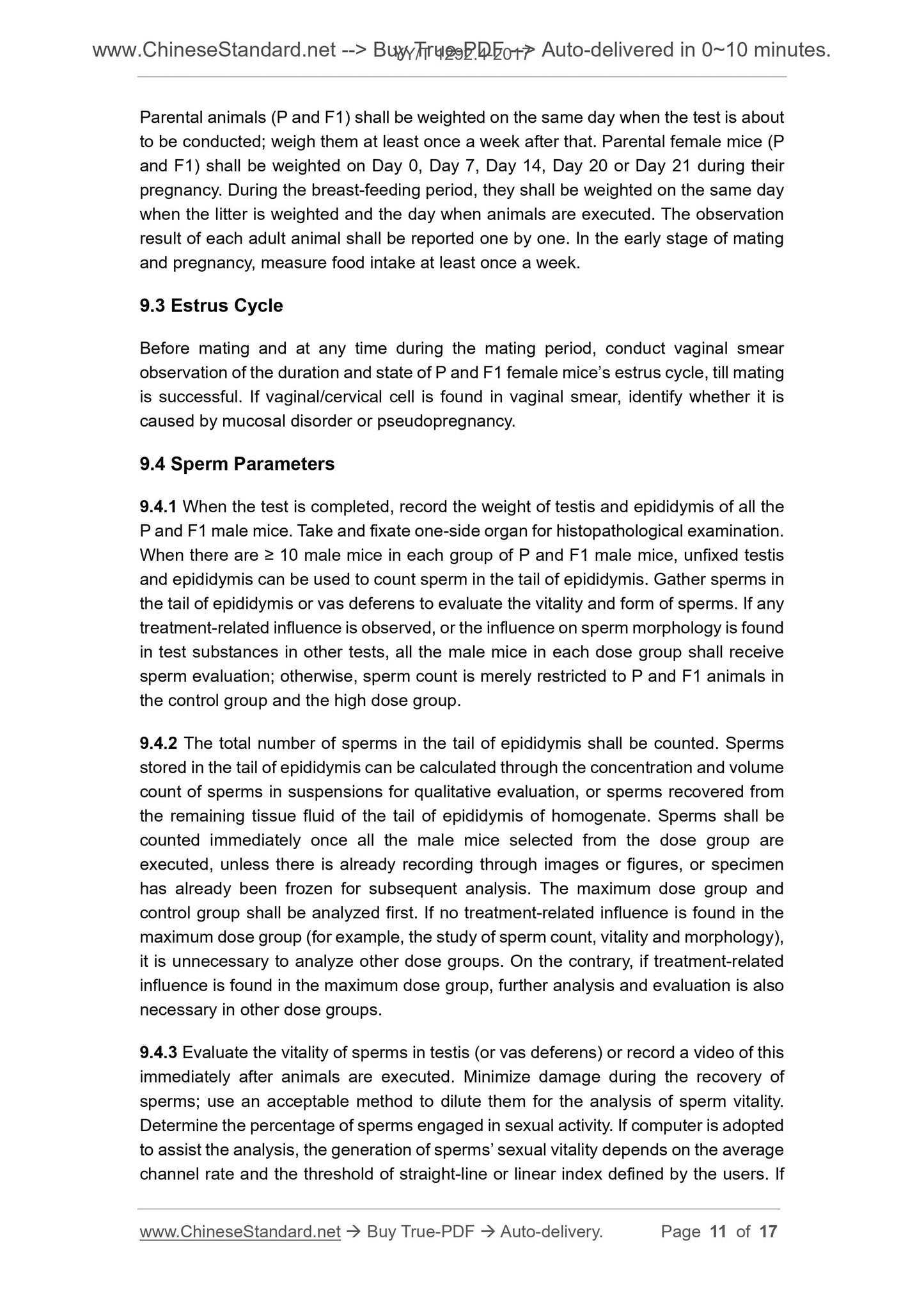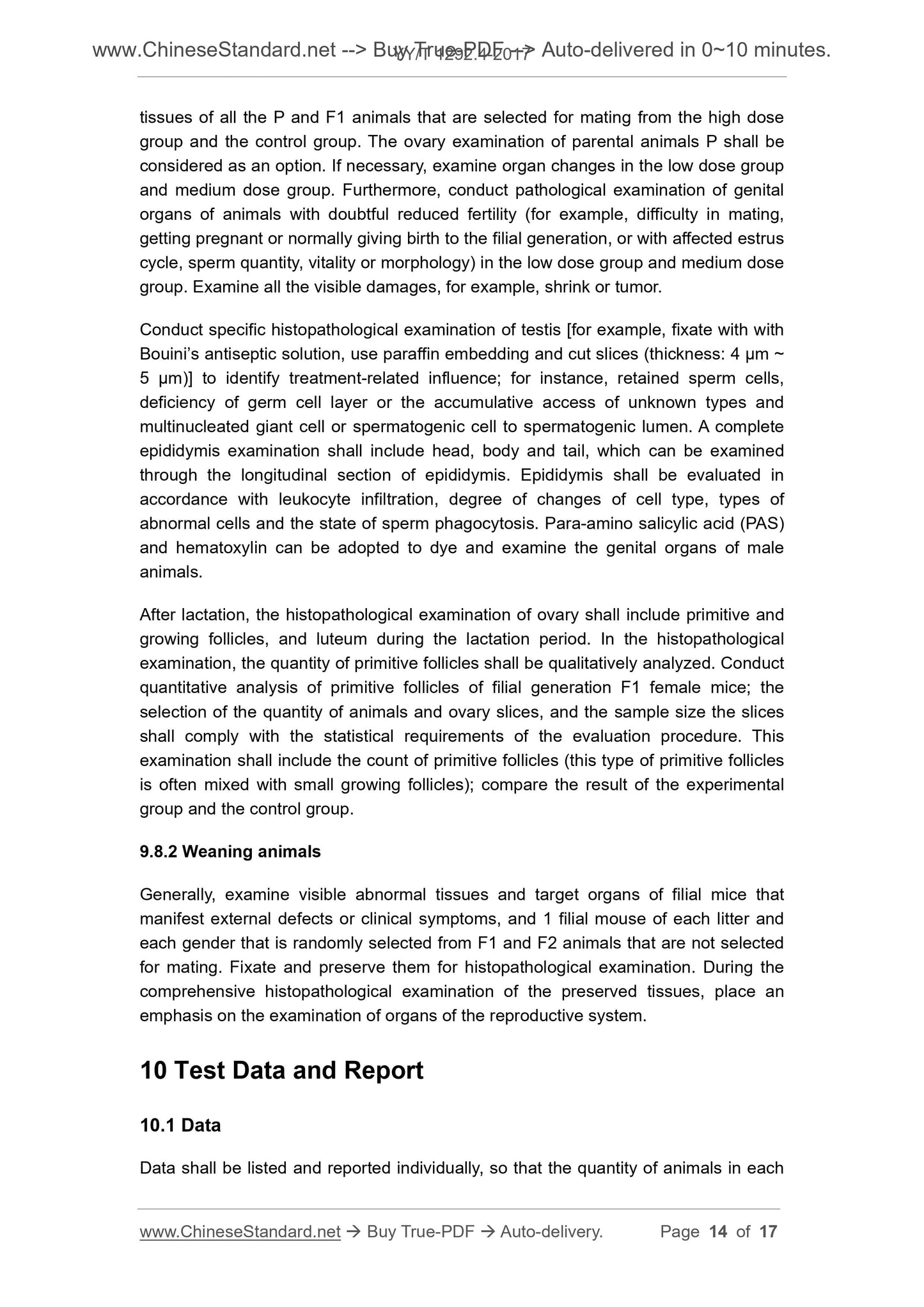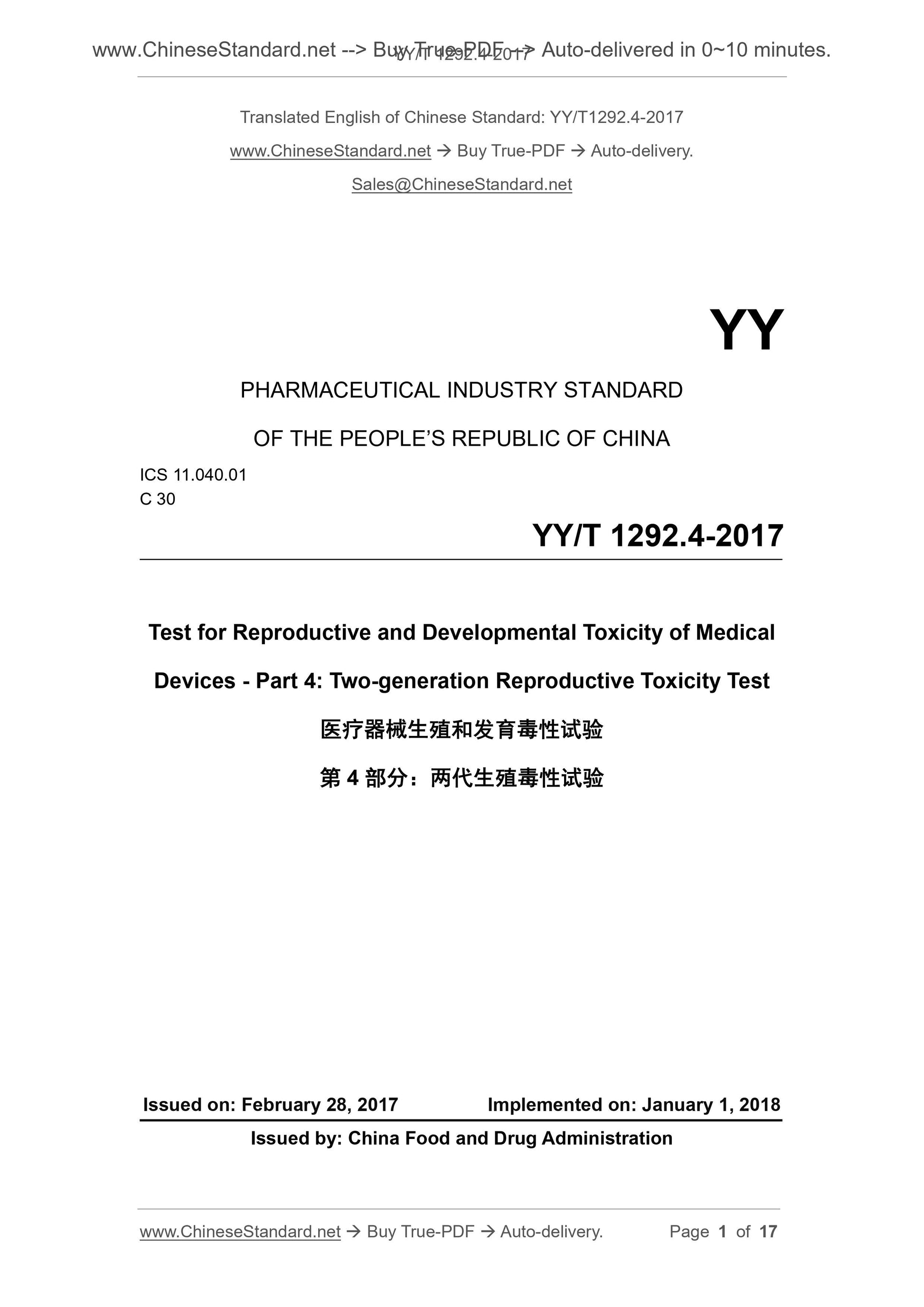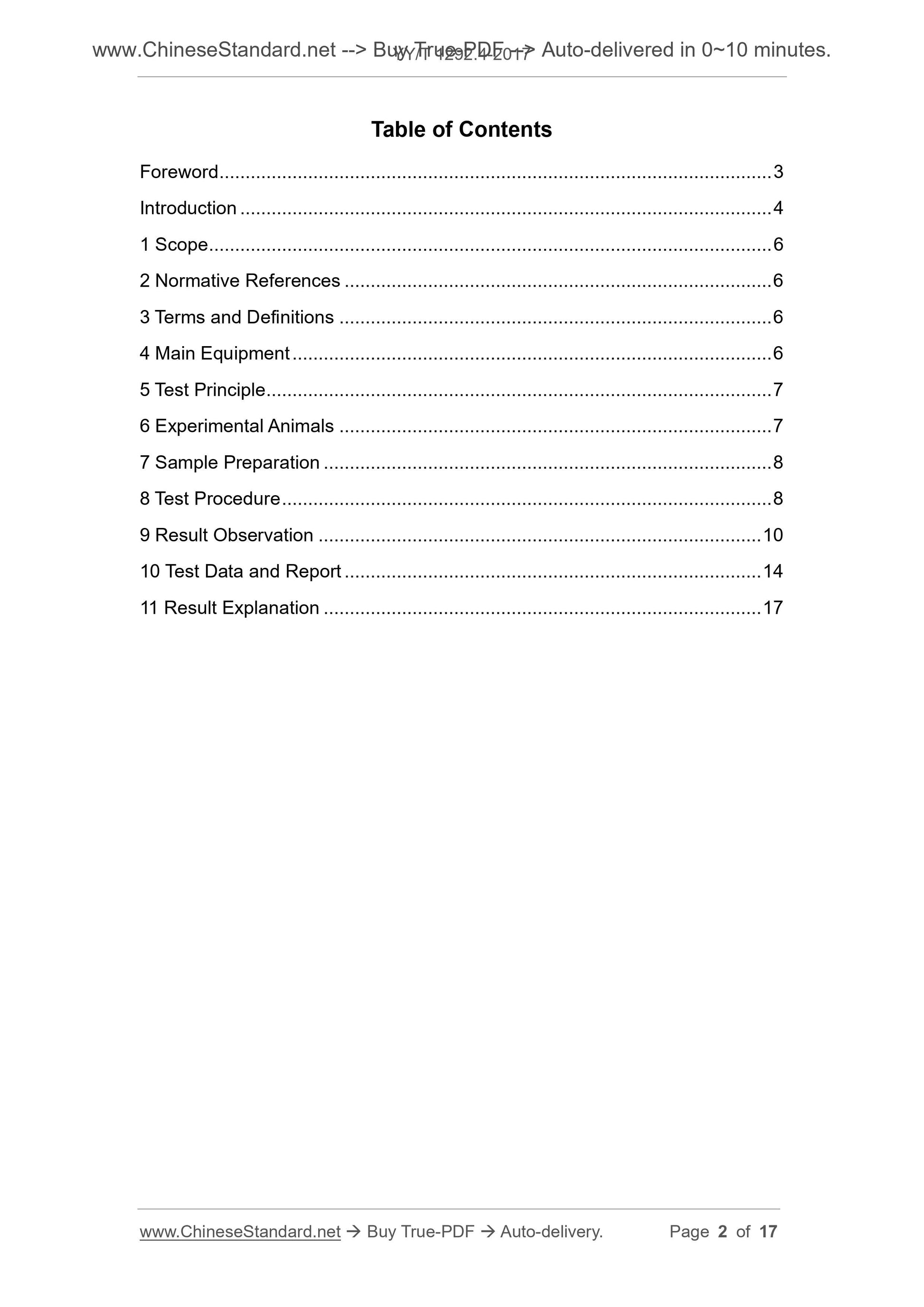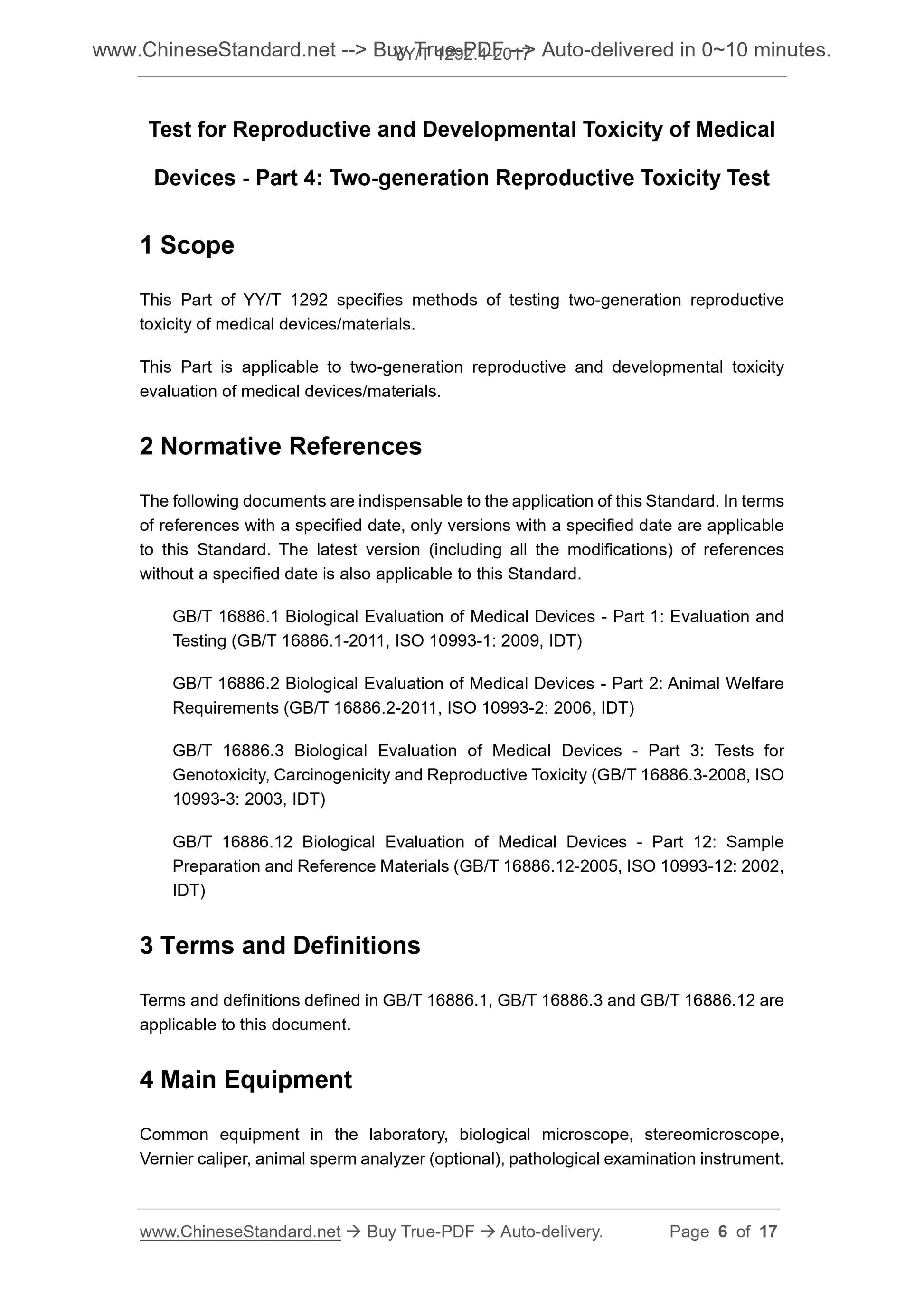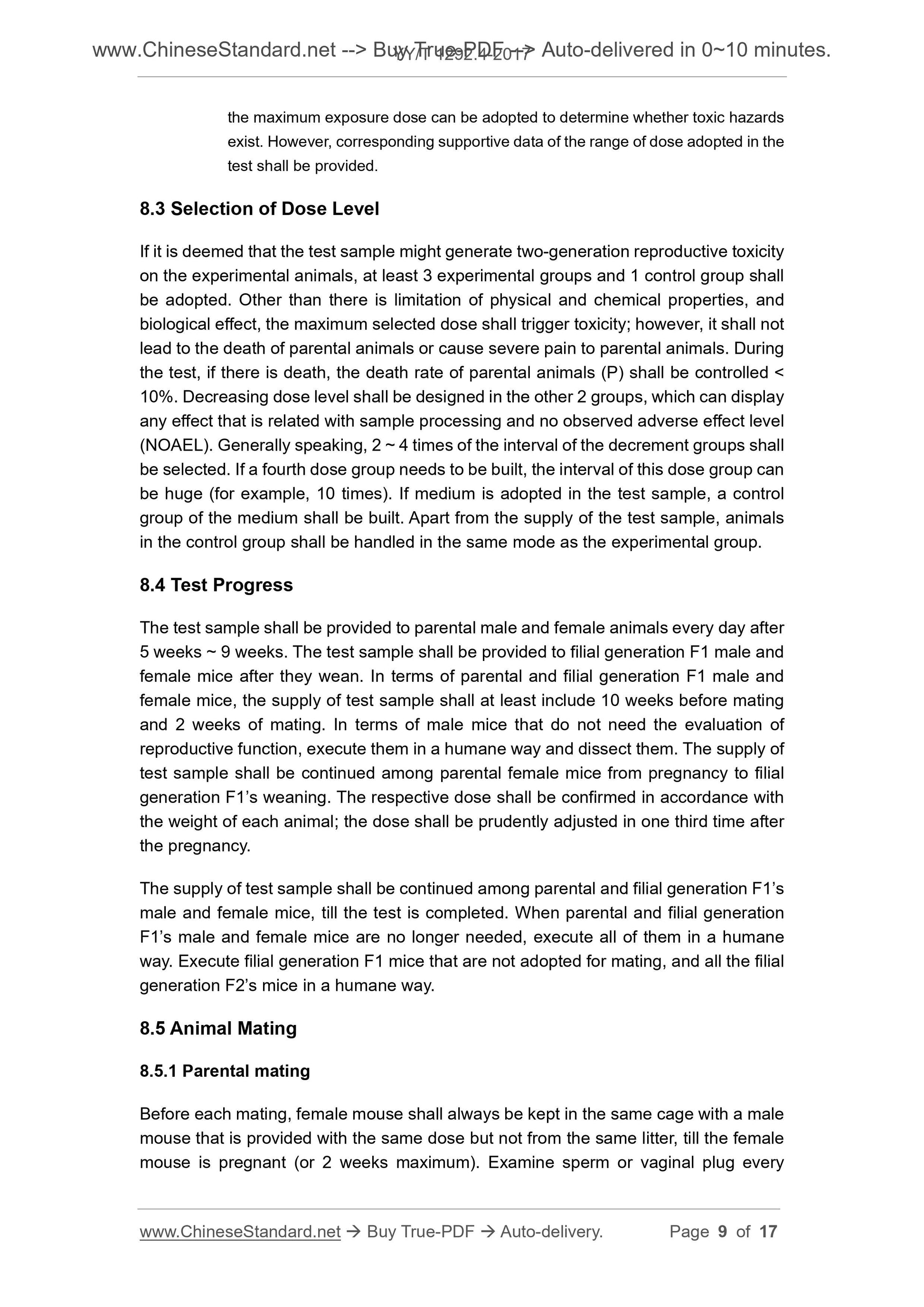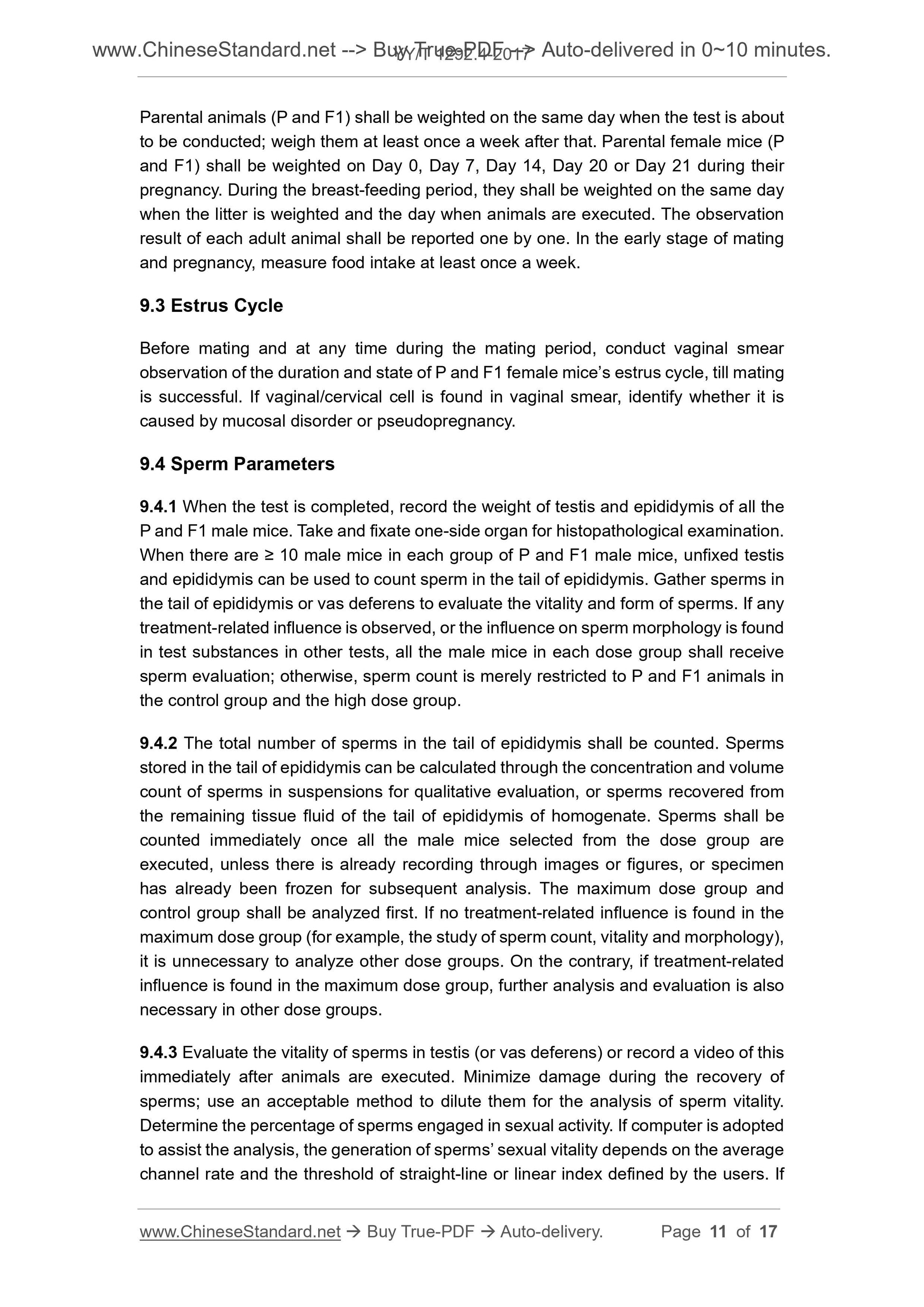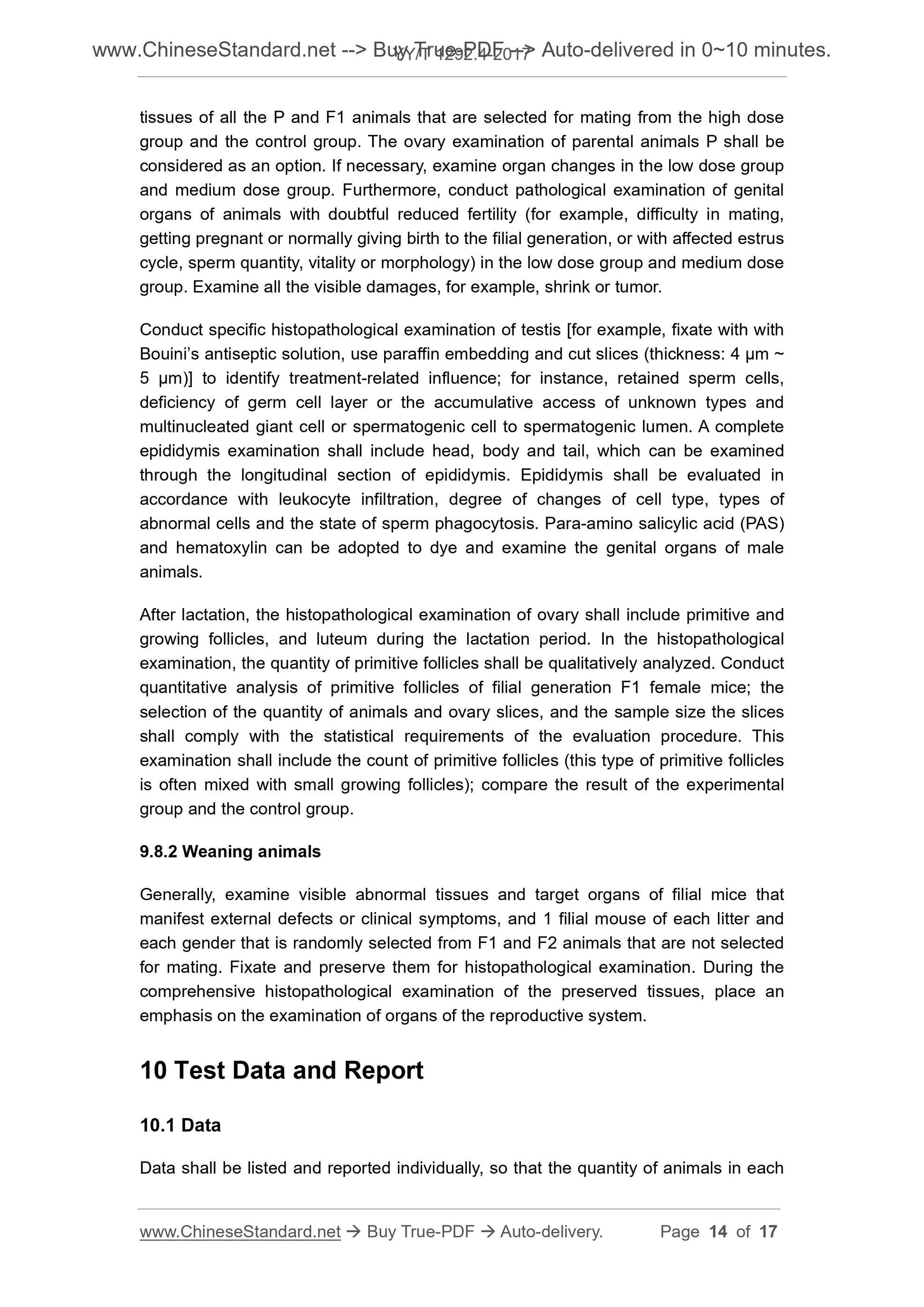1
/
の
6
PayPal, credit cards. Download editable-PDF & invoice in 1 second!
YY/T 1292.4-2017 English PDF (YYT1292.4-2017)
YY/T 1292.4-2017 English PDF (YYT1292.4-2017)
通常価格
$205.00 USD
通常価格
セール価格
$205.00 USD
単価
/
あたり
配送料はチェックアウト時に計算されます。
受取状況を読み込めませんでした
Delivery: 3 seconds. Download true-PDF + Invoice.
Get QUOTATION in 1-minute: Click YY/T 1292.4-2017
Historical versions: YY/T 1292.4-2017
Preview True-PDF (Reload/Scroll if blank)
YY/T 1292.4-2017: Test for reproductive and developmental toxicity of medical devices—Part 4: Two-generation reproductive toxicity test
YY/T 1292.4-2017
YY
PHARMACEUTICAL INDUSTRY STANDARD
OF THE PEOPLE’S REPUBLIC OF CHINA
ICS 11.040.01
C 30
Test for Reproductive and Developmental Toxicity of Medical
Devices - Part 4. Two-generation Reproductive Toxicity Test
ISSUED ON. FEBRUARY 28, 2017
IMPLEMENTED ON. JANUARY 1, 2018
Issued by. China Food and Drug Administration
Table of Contents
Foreword ... 3
Introduction ... 4
1 Scope ... 6
2 Normative References ... 6
3 Terms and Definitions ... 6
4 Main Equipment ... 6
5 Test Principle ... 7
6 Experimental Animals ... 7
7 Sample Preparation ... 8
8 Test Procedure ... 8
9 Result Observation ... 10
10 Test Data and Report ... 14
11 Result Explanation ... 17
Test for Reproductive and Developmental Toxicity of Medical
Devices - Part 4. Two-generation Reproductive Toxicity Test
1 Scope
This Part of YY/T 1292 specifies methods of testing two-generation reproductive
toxicity of medical devices/materials.
This Part is applicable to two-generation reproductive and developmental toxicity
evaluation of medical devices/materials.
2 Normative References
The following documents are indispensable to the application of this Standard. In terms
of references with a specified date, only versions with a specified date are applicable
to this Standard. The latest version (including all the modifications) of references
without a specified date is also applicable to this Standard.
GB/T 16886.1 Biological Evaluation of Medical Devices - Part 1. Evaluation and
Testing (GB/T 16886.1-2011, ISO 10993-1.2009, IDT)
GB/T 16886.2 Biological Evaluation of Medical Devices - Part 2. Animal Welfare
Requirements (GB/T 16886.2-2011, ISO 10993-2.2006, IDT)
GB/T 16886.3 Biological Evaluation of Medical Devices - Part 3. Tests for
Genotoxicity, Carcinogenicity and Reproductive Toxicity (GB/T 16886.3-2008, ISO
10993-3.2003, IDT)
GB/T 16886.12 Biological Evaluation of Medical Devices - Part 12. Sample
Preparation and Reference Materials (GB/T 16886.12-2005, ISO 10993-12.2002,
IDT)
3 Terms and Definitions
Terms and definitions defined in GB/T 16886.1, GB/T 16886.3 and GB/T 16886.12 are
applicable to this document.
4 Main Equipment
Common equipment in the laboratory, biological microscope, stereomicroscope,
Vernier caliper, animal sperm analyzer (optional), pathological examination instrument.
the maximum exposure dose can be adopted to determine whether toxic hazards
exist. However, corresponding supportive data of the range of dose adopted in the
test shall be provided.
8.3 Selection of Dose Level
If it is deemed that the test sample might generate two-generation reproductive toxicity
on the experimental animals, at least 3 experimental groups and 1 control group shall
be adopted. Other than there is limitation of physical and chemical properties, and
biological effect, the maximum selected dose shall trigger toxicity; however, it shall not
lead to the death of parental animals or cause severe pain to parental animals. During
the test, if there is death, the death rate of parental animals (P) shall be controlled <
10%. Decreasing dose level shall be designed in the other 2 groups, which can display
any effect that is related with sample processing and no observed adverse effect level
(NOAEL). Generally speaking, 2 ~ 4 times of the interval of the decrement groups shall
be selected. If a fourth dose group needs to be built, the interval of this dose group can
be huge (for example, 10 times). If medium is adopted in the test sample, a control
group of the medium shall be built. Apart from the supply of the test sample, animals
in the control group shall be handled in the same mode as the experimental group.
8.4 Test Progress
The test sample shall be provided to parental male and female animals every day after
5 weeks ~ 9 weeks. The test sample shall be provided to filial generation F1 male and
female mice after they wean. In terms of parental and filial generation F1 male and
female mice, the supply of test sample shall at least include 10 weeks before mating
and 2 weeks of mating. In terms of male mice that do not need the evaluation of
reproductive function, execute them in a humane way and dissect them. The supply of
test sample shall be continued among parental female mice from pregnancy to filial
generation F1’s weaning. The respective dose shall be confirmed in accordance with
the weight of each animal; the dose shall be prudently adjusted in one third time after
the pregnancy.
The supply of test sample shall be continued among parental and filial generation F1’s
male and female mice, till the test is completed. When parental and filial generation
F1’s male and female mice are no longer needed, execute all of them in a humane
way. Execute filial generation F1 mice that are not adopted for mating, and all the filial
generation F2’s mice in a humane way.
8.5 Animal Mating
8.5.1 Parental mating
Before each mating, female mouse shall always be kept in the same cage with a male
mouse that is provided with the same dose but not from the same litter, till the female
mouse is pregnant (or 2 weeks maximum). Examine sperm or vaginal plug every
Parental animals (P and F1) shall be weighted on the same day when the test is about
to be conducted; weigh them at least once a week after that. Parental female mice (P
and F1) shall be weighted on Day 0, Day 7, Day 14, Day 20 or Day 21 during their
pregnancy. During the breast-feeding period, they shall be weighted on the same day
when the litter is weighted and the day when animals are executed. The observation
result of each adult animal shall be reported one by one. In the early stage of mating
and pregnancy, measure food intake at least once a week.
9.3 Estrus Cycle
Before mating and at any time during the mating period, conduct vaginal smear
observation of the duration and state of P and F1 female mice’s estrus cycle, till mating
is successful. If vaginal/cervical cell is found in vaginal smear, identify whether it is
caused by mucosal disorder or pseudopregnancy.
9.4 Sperm Parameters
9.4.1 When the test is completed, record the weight of testis and epididymis of all the
P and F1 male mice. Take and fixate one-side organ for histopathological examination.
When there are ≥ 10 male mice in each group of P and F1 male mice, unfixed testis
and epididymis can be used to count sperm in the tail of epididymis. Gather sperms in
the tail of epididymis or vas deferens to evaluate the vitality and form of sperms. If any
treatment-related influence is observed, or the influence on sperm morphology is found
in test substances in other tests, all the male mice in each dose group shall receive
sperm evaluation; otherwise, sperm count is merely restricted to P and F1 animals in
the control group and the high dose group.
9.4.2 The total number of sperms in the tail of epididymis shall be counted. Sperms
stored in the tail of epididymis can be calculated through the concentration and volume
count of sperms in suspensions for qualitative evaluation, or sperms recovered from
the remaining tissue fluid of the tail of epididymis of homogenate. Sperms shall be
counted immediately once all the male mice selected from the dose group are
executed, unless there is already recording through images or figures, or specimen
has already been frozen for subsequent analysis. The maximum dose group and
control group shall be analyzed first. If no treatment-related influence is...
Get QUOTATION in 1-minute: Click YY/T 1292.4-2017
Historical versions: YY/T 1292.4-2017
Preview True-PDF (Reload/Scroll if blank)
YY/T 1292.4-2017: Test for reproductive and developmental toxicity of medical devices—Part 4: Two-generation reproductive toxicity test
YY/T 1292.4-2017
YY
PHARMACEUTICAL INDUSTRY STANDARD
OF THE PEOPLE’S REPUBLIC OF CHINA
ICS 11.040.01
C 30
Test for Reproductive and Developmental Toxicity of Medical
Devices - Part 4. Two-generation Reproductive Toxicity Test
ISSUED ON. FEBRUARY 28, 2017
IMPLEMENTED ON. JANUARY 1, 2018
Issued by. China Food and Drug Administration
Table of Contents
Foreword ... 3
Introduction ... 4
1 Scope ... 6
2 Normative References ... 6
3 Terms and Definitions ... 6
4 Main Equipment ... 6
5 Test Principle ... 7
6 Experimental Animals ... 7
7 Sample Preparation ... 8
8 Test Procedure ... 8
9 Result Observation ... 10
10 Test Data and Report ... 14
11 Result Explanation ... 17
Test for Reproductive and Developmental Toxicity of Medical
Devices - Part 4. Two-generation Reproductive Toxicity Test
1 Scope
This Part of YY/T 1292 specifies methods of testing two-generation reproductive
toxicity of medical devices/materials.
This Part is applicable to two-generation reproductive and developmental toxicity
evaluation of medical devices/materials.
2 Normative References
The following documents are indispensable to the application of this Standard. In terms
of references with a specified date, only versions with a specified date are applicable
to this Standard. The latest version (including all the modifications) of references
without a specified date is also applicable to this Standard.
GB/T 16886.1 Biological Evaluation of Medical Devices - Part 1. Evaluation and
Testing (GB/T 16886.1-2011, ISO 10993-1.2009, IDT)
GB/T 16886.2 Biological Evaluation of Medical Devices - Part 2. Animal Welfare
Requirements (GB/T 16886.2-2011, ISO 10993-2.2006, IDT)
GB/T 16886.3 Biological Evaluation of Medical Devices - Part 3. Tests for
Genotoxicity, Carcinogenicity and Reproductive Toxicity (GB/T 16886.3-2008, ISO
10993-3.2003, IDT)
GB/T 16886.12 Biological Evaluation of Medical Devices - Part 12. Sample
Preparation and Reference Materials (GB/T 16886.12-2005, ISO 10993-12.2002,
IDT)
3 Terms and Definitions
Terms and definitions defined in GB/T 16886.1, GB/T 16886.3 and GB/T 16886.12 are
applicable to this document.
4 Main Equipment
Common equipment in the laboratory, biological microscope, stereomicroscope,
Vernier caliper, animal sperm analyzer (optional), pathological examination instrument.
the maximum exposure dose can be adopted to determine whether toxic hazards
exist. However, corresponding supportive data of the range of dose adopted in the
test shall be provided.
8.3 Selection of Dose Level
If it is deemed that the test sample might generate two-generation reproductive toxicity
on the experimental animals, at least 3 experimental groups and 1 control group shall
be adopted. Other than there is limitation of physical and chemical properties, and
biological effect, the maximum selected dose shall trigger toxicity; however, it shall not
lead to the death of parental animals or cause severe pain to parental animals. During
the test, if there is death, the death rate of parental animals (P) shall be controlled <
10%. Decreasing dose level shall be designed in the other 2 groups, which can display
any effect that is related with sample processing and no observed adverse effect level
(NOAEL). Generally speaking, 2 ~ 4 times of the interval of the decrement groups shall
be selected. If a fourth dose group needs to be built, the interval of this dose group can
be huge (for example, 10 times). If medium is adopted in the test sample, a control
group of the medium shall be built. Apart from the supply of the test sample, animals
in the control group shall be handled in the same mode as the experimental group.
8.4 Test Progress
The test sample shall be provided to parental male and female animals every day after
5 weeks ~ 9 weeks. The test sample shall be provided to filial generation F1 male and
female mice after they wean. In terms of parental and filial generation F1 male and
female mice, the supply of test sample shall at least include 10 weeks before mating
and 2 weeks of mating. In terms of male mice that do not need the evaluation of
reproductive function, execute them in a humane way and dissect them. The supply of
test sample shall be continued among parental female mice from pregnancy to filial
generation F1’s weaning. The respective dose shall be confirmed in accordance with
the weight of each animal; the dose shall be prudently adjusted in one third time after
the pregnancy.
The supply of test sample shall be continued among parental and filial generation F1’s
male and female mice, till the test is completed. When parental and filial generation
F1’s male and female mice are no longer needed, execute all of them in a humane
way. Execute filial generation F1 mice that are not adopted for mating, and all the filial
generation F2’s mice in a humane way.
8.5 Animal Mating
8.5.1 Parental mating
Before each mating, female mouse shall always be kept in the same cage with a male
mouse that is provided with the same dose but not from the same litter, till the female
mouse is pregnant (or 2 weeks maximum). Examine sperm or vaginal plug every
Parental animals (P and F1) shall be weighted on the same day when the test is about
to be conducted; weigh them at least once a week after that. Parental female mice (P
and F1) shall be weighted on Day 0, Day 7, Day 14, Day 20 or Day 21 during their
pregnancy. During the breast-feeding period, they shall be weighted on the same day
when the litter is weighted and the day when animals are executed. The observation
result of each adult animal shall be reported one by one. In the early stage of mating
and pregnancy, measure food intake at least once a week.
9.3 Estrus Cycle
Before mating and at any time during the mating period, conduct vaginal smear
observation of the duration and state of P and F1 female mice’s estrus cycle, till mating
is successful. If vaginal/cervical cell is found in vaginal smear, identify whether it is
caused by mucosal disorder or pseudopregnancy.
9.4 Sperm Parameters
9.4.1 When the test is completed, record the weight of testis and epididymis of all the
P and F1 male mice. Take and fixate one-side organ for histopathological examination.
When there are ≥ 10 male mice in each group of P and F1 male mice, unfixed testis
and epididymis can be used to count sperm in the tail of epididymis. Gather sperms in
the tail of epididymis or vas deferens to evaluate the vitality and form of sperms. If any
treatment-related influence is observed, or the influence on sperm morphology is found
in test substances in other tests, all the male mice in each dose group shall receive
sperm evaluation; otherwise, sperm count is merely restricted to P and F1 animals in
the control group and the high dose group.
9.4.2 The total number of sperms in the tail of epididymis shall be counted. Sperms
stored in the tail of epididymis can be calculated through the concentration and volume
count of sperms in suspensions for qualitative evaluation, or sperms recovered from
the remaining tissue fluid of the tail of epididymis of homogenate. Sperms shall be
counted immediately once all the male mice selected from the dose group are
executed, unless there is already recording through images or figures, or specimen
has already been frozen for subsequent analysis. The maximum dose group and
control group shall be analyzed first. If no treatment-related influence is...
Share
